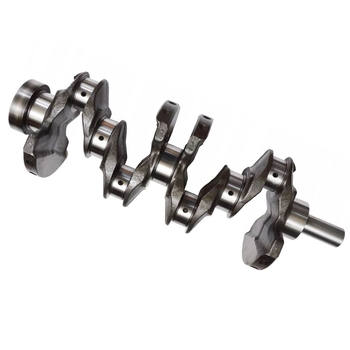
The age-old question for performance enthusiasts: is a lighter crankshaft better? It's a complex topic with no simple yes or no answer. A lighter crankshaft can offer significant performance advantages, but it's crucial to understand the trade-offs and consider your specific application. This article will delve into the pros and cons of a lighter crankshaft, helping you decide if it's the right upgrade for your engine.
The Advantages of a Lighter Crankshaft
Reduced rotating mass is the primary benefit of a lighter crankshaft. Think of it like this: it takes less energy to spin a lighter object than a heavier one. This translates to quicker engine acceleration and improved throttle response. The engine feels more eager to rev and build power, providing a more dynamic driving experience. Furthermore, a lighter rotating assembly, which includes the crankshaft, connecting rods, and pistons, reduces parasitic losses, freeing up horsepower and potentially improving fuel efficiency. For racing applications, this can be the difference between winning and losing.
The Disadvantages of a Lighter Crankshaft
While a lighter crankshaft offers performance gains, it also presents potential drawbacks. One major concern is decreased engine longevity. A lighter crankshaft can be more susceptible to flexing and fatigue, especially under high stress conditions. This is particularly relevant for high-performance engines generating significant horsepower and torque. Another consideration is the potential for increased vibrations. A heavier crankshaft inherently dampens vibrations more effectively, leading to smoother engine operation.
Balancing Act: Finding the Right Crankshaft Weight
Choosing the right crankshaft weight is a balancing act between performance and reliability. Factors like engine displacement, intended use (street or track), and power output all play a role in determining the optimal crankshaft weight. For a daily driver, a moderately lighter crankshaft can provide a noticeable performance boost without significantly compromising reliability. However, for high-revving race engines, a more aggressive weight reduction might be necessary, accepting the potential trade-offs in longevity. What are your performance goals? This question should be at the forefront of your decision-making process.
Crankshaft Material and Construction
The material and construction of the crankshaft also influence its weight and performance characteristics. Common materials include forged steel, cast iron, and billet steel. Forged steel crankshafts are generally stronger and lighter than cast iron, making them a popular choice for performance applications. Billet steel crankshafts, machined from a solid block of steel, offer the highest strength and allow for more intricate designs, but they come at a premium cost. Lightweight crankshaft materials like titanium are also available, but their high cost often limits them to top-tier motorsport applications.
Crankshaft Balancing: A Crucial Step
Regardless of the crankshaft's weight, proper balancing is essential. Crankshaft balancing ensures that the rotating assembly spins smoothly and minimizes vibrations. This is particularly critical for lighter crankshafts, as imbalances can be magnified and lead to premature engine wear or even catastrophic failure. Professional crankshaft balancing is a must for any performance engine build.
Lighter Crankshaft for Street Cars: Is it Worth It?
For street-driven vehicles, a moderately lighter crankshaft can provide a noticeable improvement in throttle response and acceleration. However, it’s important to choose a crankshaft designed for street use and ensure it’s properly balanced. Consider the long-term reliability implications and choose a reputable manufacturer known for quality and durability.
Lighter Crankshafts in Motorsports: Pushing the Limits
In the world of motorsports, lighter crankshafts are often essential for maximizing engine performance. Every ounce of rotating mass saved translates to quicker acceleration and faster lap times. However, the extreme demands of racing require careful consideration of crankshaft material, construction, and balancing to ensure reliability under high stress. The longevity of a lighter crankshaft in a race engine is often a secondary concern to outright performance.
Beyond the Crankshaft: Optimizing the Rotating Assembly
While a lighter crankshaft is a key component, optimizing the entire rotating assembly is crucial for maximizing performance gains. Lightweight connecting rods and pistons, along with proper balancing, contribute to reducing rotating mass and improving engine response. A holistic approach to engine building is essential for achieving optimal results. So, is a lighter crankshaft better? It depends on your specific application and priorities.
Making the Right Decision for Your Engine
Ultimately, the decision of whether or not to go with a lighter crankshaft depends on your individual needs and goals. Carefully weigh the pros and cons, considering your budget, performance objectives, and desired level of reliability. Consulting with a qualified engine builder is highly recommended to determine the best course of action for your specific application. Do you prioritize faster acceleration and responsiveness over potential longevity concerns? Answering this question will help guide you toward the best choice. Remember to factor in the cost of professional balancing and installation when budgeting for this upgrade.

 The Unseen Powerhouse: Unveili
The Unseen Powerhouse: Unveili
 Unveiling the Precision: The A
Unveiling the Precision: The A
 Navigating the World of Cranks
Navigating the World of Cranks
 The Unsung Heroes: What Makes
The Unsung Heroes: What Makes
